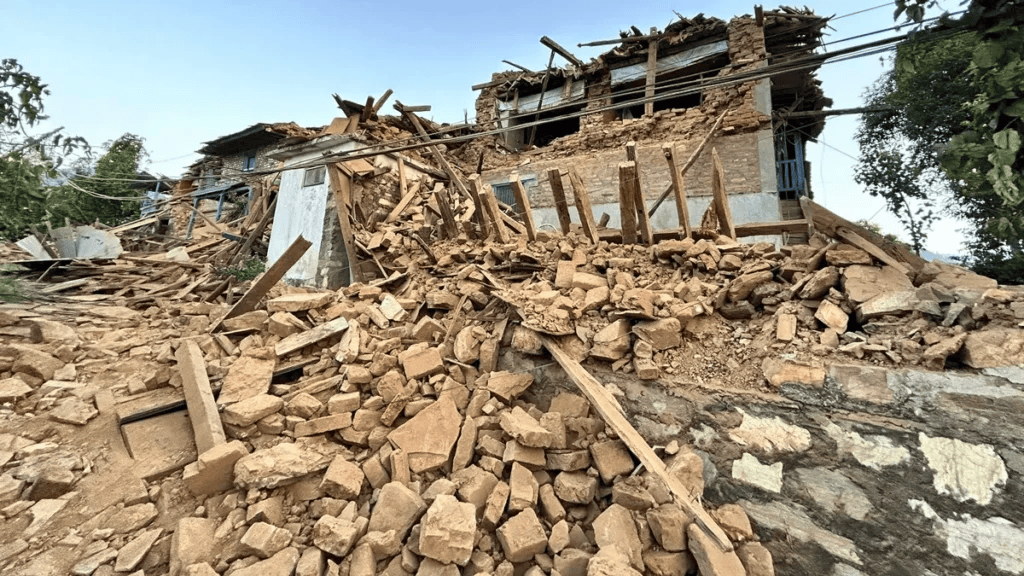A massive earthquake shook Nepal and parts of India, including Bihar, on January 7, 2025, leaving a trail of destruction and heartbreak. With a magnitude of 7.1, this seismic event, centered near the Tibet-Nepal border, reminded the world of the relentless power of nature. The Bihar Nepal earthquake has underscored the urgent need for enhanced disaster preparedness and infrastructure resilience in the region. The latest earthquake in Nepal and Bihar has prompted swift rescue operations and international aid efforts to assist affected communities. As people across the region deal with the aftermath, stories of survival, solidarity, and resilience are emerging as beacons of hope.
The Moment the Earth Trembled
At 3:27 AM local time, the stillness of the night was broken by violent tremors. Nepal bore the brunt of the disaster, with its northern regions experiencing the strongest shocks. The epicenter was located in Tibet, approximately 93 kilometers from Lobuche, Nepal, a region known for its rugged terrain and proximity to tectonic fault lines.
The quake’s effects extended into India, particularly Bihar, where districts bordering Nepal experienced strong tremors. In the state capital, Patna, and cities like Muzaffarpur, residents reported feeling the ground shake for over 30 seconds, triggering panic and chaos.
Casualties and Damage
Early reports confirmed over 50 fatalities in Tibet, while Nepal reported significant loss of life, injuries, and structural collapse. In Bihar, no major fatalities were reported initially, but many sustained injuries, and property damage was widespread. Schools, hospitals, and homes in both rural and urban areas bore the brunt of the tremors, with cracks appearing in walls and foundations.
In Nepal’s capital, Kathmandu, several heritage buildings, including centuries-old temples, sustained damage, bringing back haunting memories of the devastating 2015 Gorkha earthquake.
The Science Behind the Quake
This earthquake, part of the latest earthquake in Nepal and Bihar, was the result of tectonic activity along the convergent boundary where the Indian Plate pushes against the Eurasian Plate. The Himalayas, formed by this ongoing collision, are a hotspot for seismic activity. Experts noted that the quake’s shallow depth amplified its destructive power, as the energy had less distance to travel before reaching the surface.
Seismologists warn that the region remains highly vulnerable to future quakes, making disaster preparedness a necessity rather than an option.
Emergency Response: A Race Against Time
Rescue teams were deployed almost immediately in Nepal, with international aid pouring in to support relief efforts. Helicopters were dispatched to remote areas to transport medical supplies and evacuate injured residents. In Bihar, the National Disaster Response Force (NDRF) worked alongside local authorities to assess damage and provide relief to affected families.
Temporary shelters were set up in both regions to house those who lost their homes. Hospitals faced a surge in patients, with doctors working around the clock to treat injuries.
Aftershocks and Anxiety
The earthquake was followed by multiple aftershocks, some registering magnitudes above 5.0. These aftershocks further weakened already fragile structures and deepened the anxiety among residents. Experts urged people to stay vigilant, avoid damaged buildings, and follow safety protocols.
Stories of Hope Amid Despair
In the midst of despair, acts of bravery and humanity stood out.
A Teacher’s Heroism:
In a remote Nepali village, a school teacher turned his classroom into a refuge for displaced families, ensuring that they had food and warmth during the cold night.
A Young Boy’s Rescue:
In Bihar, a 10-year-old boy trapped under rubble for eight hours was pulled out alive by rescue workers, sparking celebrations and renewed hope.
Community Kitchens:
In Patna and Kathmandu, local volunteers set up community kitchens to serve hot meals to survivors and rescue workers, showcasing the strength of human spirit.

Global Response and Support
The international community has rallied to assist Nepal and India. Countries like the United States, Japan, and the United Kingdom pledged financial aid and sent rescue teams. Non-governmental organizations (NGOs) and the United Nations are coordinating efforts to provide food, water, and medical supplies.
Social media platforms have become lifelines for affected families, with users sharing updates, safety tips, and resources. Crowdfunding campaigns are also raising money to support rehabilitation efforts.
Looking Forward: Preparing for the Future
This disaster underscores the urgent need for enhanced disaster resilience in the region. Key steps include:
Earthquake-Resistant Infrastructure:
Governments must enforce building codes that prioritize seismic safety, especially in high-risk zones.
Public Awareness Campaigns:
Educating communities about earthquake preparedness can save lives during future disasters.
Early Warning Systems:
Expanding seismic monitoring networks can provide precious seconds of warning to residents.
International Collaboration:
Sharing technology and expertise can strengthen regional disaster management efforts.
Resilience Redefined
The people of Nepal and Bihar have shown extraordinary resilience in the face of tragedy. The latest earthquake in Nepal and Bihar has brought immense challenges, but it has also highlighted the strength and solidarity of the affected communities. As the rebuilding process begins, their courage and unity serve as a reminder that even amidst devastation, the human spirit remains unbreakable.





